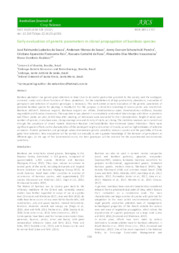Early evaluation of genetic parameters in clonal propagation of bamboo species.
Early evaluation of genetic parameters in clonal propagation of bamboo species.
Autoria: SOUSA, J. R. L. de; SOUZA, A. M. de; PEREIRA, J. E. S.; REIS, C. A. F.; ROSA, R. C. da; VASCONCELOS, A. D. M.; RADDATZ, D. D.
Resumo: Bamboo plantation has gained great attention in Brazil due to its useful production provided to the society and the ecological, economic, social and cultural functions of these plantations. For the establishment of high productivity plantations, evaluation of germplasm and selection of superior genotypes is necessary. This work aimed at early evaluation of the genetic parameters of potential bamboo species for planting in Brasília/DF. For this purpose, a clonal test consisting of seven species was established: Bambusa oldhamii, Bambusa vulgaris, Bambusa vulgaris var. vittata, Dendrocalamus asper, Dendrocalamus latiflorus, Guadua angustifolia and Guadua chacoensis. The experiment was planted in a completely randomized block design, with three replications and fifteen plants per plot. At 360 days after planting, all individuals were evaluated for their characteristics: height of aerial part, number of sprouts, clump base area, clump coverage area and density of stalks per clump. The statistical analyses were carried out through the procedure of mixed models: Maximum Residual Likelihood/Better Non-Victimised Linear Prediction. There were significant species effects on the characteristics of the aerial part height and number of shoots, as well as high estimates of selective accuracies. Genetic parameters and genotypic values demonstrate genetic variability between species and the possibility of future gains from selection. New evaluations will be carried out annually to aim a greater knowledge of the behavior of germplasms at different ages. At the age of five (commercial court), the best genotypes will be selected for the experimental environmental conditions.
Ano de publicação: 2022
Tipo de publicação: Artigo de periódico
Unidade: Embrapa Florestas
Palavras-chave: Bamboos, Bambu, Bambusa Vulgaris, Bambusa oldhamii, Brasília/DF, Dendrocalamus asper, Genetic parameters, Guadua angustifolia, Guadua chacoensis
Observações
1 - Por padrão são exibidas publicações dos últimos 20 anos. Para encontrar publicações mais antigas, configure o filtro ano de publicação, colocando o ano a partir do qual você deseja encontrar publicações. O filtro está na coluna da esquerda na busca acima.
2 - Para ler algumas publicações da Embrapa (apenas as que estão em formato ePub), é necessário ter, no celular ou computador, um desses softwares gratuitos. Sistemas Android: Google Play Livros; IOS: iBooks; Windows e Linux: software Calibre.
Acesse outras publicações
Acesse a Base de Dados da Pesquisa Agropecuária (BDPA) para consultar o acervo completo das bibliotecas da Embrapa.

